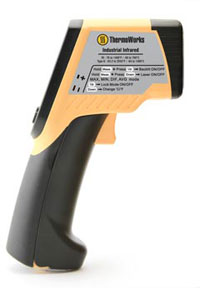The Limitations of Infrared Thermometers
Infrared thermometers can be very useful when used in the right way and put to task in the right applications. However, before you can develop confidence in their ability to give fast temperatures, you must understand their limitations.
 Infrared thermometers:
Infrared thermometers:
- Only measure surface temperatures and NOT the internal temperature of food or other materials
- Require adjustments depending on the surface being measured (See Adjust for Emissivity)
- Are not thought to be as highly accurate as surface probes measurements of the same *surface
- Can be temporarily affected by frost, moisture, dust, fog, smoke or other particles in the air
- Can be temporarily affected by rapid changes in ambient temperature
- Can be temporarily affected by proximity to a radio frequency with an electromagnetic field strength of three volts per meter or greater
- Do not "see through" glass, liquids or other transparent surfaces - even though visible light (like a laser) passes through them (i.e. if you point an IR gun at a window, you'll be measuring the temperature of the window pane, not the outside temp)
* In some cases, Infrared Thermometers can be MORE accurate than a surface probe because surface probes have their own temperature and can affect the surface being measured by coming into contact with it.
